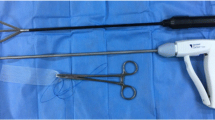Abstract
Introduction and hypothesis
The study aims to report an extended follow-up of our case series of sacrohysteropexy for pelvic organ prolapse (POP).
Methods
Fifty-five patients with symptomatic POP underwent uterus sparing surgery. All patients were followed up for 1, 3, 6 and 12 months and then annually. Objective success was defined as a well-supported cervix and no vaginal prolapse stage ≥ 2. Subjective success was no prolapse-related symptoms or voiding disorder.
Results
The mean follow-up was 60 ± 34 months. Anterior compartment prolapse (cystocele) stage ≥ 2 was present in four out of 52 patients (7.7%), while posterior compartment prolapse (rectocele) stage ≥ 2 was present in three (5.7%). Voiding symptoms were resolved in 42 out of 45 patients (93.4%) and storage symptoms in 30 out of 36 (83.3%); one patient reported de novo urgency. Sexual activity was maintained in 28 out of 29 patients (95.5%). Four patients showed de novo stress urinary incontinence.
Conclusion
Our findings support the use of uterus preservation, with significative objective and subjective outcomes in treating POP.
Similar content being viewed by others
References
Samuelsson EC, Victor FT, Tibblin G, Svardsudd KF (1999) Signs of genital prolapse in a Swedish population of women 20 to 59 years of age and possible related factors. Am J Obstet Gynecol 180:299–305
Olsen AL, Smith VJ, Bergstrom JO, Colling JC, Clark AL (1997) Epidemiology of surgically managed pelvic organ prolapse and urinary incontinence. Obstet Gynecol 89:501–506
Subak LL, Waetjen LE, van den Eeden S, Thom DH, Vittinghoff E, Brown JS (2001) Cost of pelvic organ prolapse surgery in the United States. Obstet Gynecol 98:646–651
Nygaard IE, McCreery R, Brubaker L, Pelvic Floor Disorders Network et al (2004) Abdominal sacrocolpopexy: a comprehensive review. Obstet Gynecol 104:805–812
Swati JHA, Moran PA (2007) National survey of prolapse in the UK. Neurol Urodyn 26:325–331
de Boer TA, Milani AL, Kluivers KB, Withagen MI, Vierhout ME (2009) The effectiveness of surgical correction of uterine prolapse: cervical amputation with uterosacral ligament plication (modified Manchester) versus vaginal hysterectomy with high uterosacral ligament plication. Int Urogynecol J Pelvic Floor Dysfunct 20:1313–1319
Hilton P (2009) Long-term follow-up studies in pelvic floor dysfunction: the Holy Grail or a realistic aim. BJOG 115:135–143
Bump RC, Mattiasson A, Bo K et al (1996) The standardization of terminology of female pelvic organ prolapse and pelvic floor dysfunction. Am J Obstet Gynecol 175:10–17
Abrams P, Cardozo L, Fall M, Standardisation Sub-committee of the International Continence Society et al (2002) The standardisation of terminology of lower urinary tract function: report from the Standardisation Sub-committee of the International Continence Society. Neurourol Urodyn 21:167–178
Costantini E, Mearini L, Bini V, Zucchi A, Mearini E, Porena M (2005) Uterus preservation in surgical correction of urogenital prolapse. Eur Urol 48:642–649
Altman D, Granath F, Cnattingius S, Falconer C (2007) Hysterectomy and risk of stress-urinary-incontinence surgery: nationwide cohort study. Lancet 370:1494–1499
Richardson DA, Scotti RJ, Ostergard DR (1989) Surgical management of uterine prolapse in young women. J Reprod Med 34:388–392
Kovac SR, Cruikshank SH (1993) Successful pregnancies and vaginal deliveries after sacrospinous uterosacral fixation in five of nineteen patients. Am J Obstet Gynecol 168:1778–1783
Zucchi A, Lazzeri M Porena M, Del Zingaro M, Costantini E (2010) Uterus preservation in prolapse surgery. Nat Med 7:626–633
Dietz V, Koops SES, van der Vaart CH (2009) Vaginal surgery for uterine descent; which options do we have? A review of the literature. Int Urogynecol J 20:349–356
Rozet F, Mandron E, Arroyo C et al (2005) Laparoscopic sacral colpopexy approach for genito-urinary prolapse: experience with 363 cases. Eur Urol 47:230–236
Price N, Slack A, Jakson SR (2010) Laparoscopic hysteropexy: the initial results of a uterine suspension procedure for uterovaginal prolapse. BJOG 117:62–68
Neuman M, Lavy Y (2007) Conservation of the prolapsed uterus is a valid option: medium term results of a prospective comparative study with the posterior intravaginal slingplasty operation. Int Urogynecol J 18:889–893
Hefni M, El-Toukhy T, Bhaumik J, Katsimanis E (2003) Sacrospinous cervicocolpopexy with uterine conservation for uterovaginal prolapse in elderly women: an evolving concept. Am J Obstet Gynecol 188:645–650
van Brummen HJ, van de Pol G, Aalders CI, Heintz AP, van der Vaart CH (2003) Sacrospinous hysteropexy compared to vaginal hysterectomy as primary surgical treatment for a descensus uteri: effects on urinary symptoms. Int Urogynecol J Pelvic Floor Dysfunct 14:350–355
Ozcan U, Gungor T, Ekin M, Eken S (1999) Sacrospinous fixation for the prolapsed vaginal vault. Gynecol Obstet Invest 47:65–68
Nicita G, Li Marzi V, Filocamo MT et al (2005) Uterus-sparing vaginal surgery of genitourinary prolapse employing biocompatible material. Urol Int 75:314–318
Higgs P, Goh J, Krause H, Sloane K, Carey M (2005) Abdominal sacral colpopexy: an independent prospective long-term follow-up study. Aust N Z J Obstet Gynaecol 45:430–434
Lin LL, Ho MH, Haessler AL, Betson LH, Alisond RM, Liu CY, Bhatia NN (2005) A review of laparoscopic uterine suspension procedures for uterine preservation. Curr Opin Obstet Gynecol 17:541–546
Brubaker L, Cundiff GW, Fine P, Nygaard I, Richter HE, Visco AG et al (2006) Abdominal sacrocolpopexy with Burch colposuspension to reduce urinary stress incontinence. N Engl J Med 354:1557–1566
Costantini E, Zucchi A, Giannantoni A, Mearini L, Bini V, Porena M (2007) Must colposuspension be associated with sacropexy to prevent postoperative urinary incontinence. Eur Urol 51:788–794
Costantini E, Lazzeri M, Bini V, Del Zingaro M, Zucchi A, Porena M (2008) Burch colposuspension does not provide any additional benefit to pelvic organ prolapse repair in patients with urinary incontinence: a randomized surgical trial. J Urol 180:1007–1012
Acknowledgment
Geraldine Boyd revised the linguistic style of the paper.
Conflicts of interest
None.
Author information
Authors and Affiliations
Corresponding author
Rights and permissions
About this article
Cite this article
Costantini, E., Lazzeri, M., Zucchi, A. et al. Five-year outcome of uterus sparing surgery for pelvic organ prolapse repair: a single-center experience. Int Urogynecol J 22, 287–292 (2011). https://doi.org/10.1007/s00192-010-1342-7
Received:
Accepted:
Published:
Issue Date:
DOI: https://doi.org/10.1007/s00192-010-1342-7



